Best smart trainers 2024: Immersive indoor cycling for all
Get set up for your best winter ever with our guide to the best wheel-on and direct-drive smart trainers available today
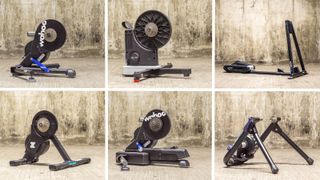
1. Quick list
2. Direct-drive smart trainers
- Best overall
- Runner up
- Best budget
- Cheapest high-spec
- Most realistic ride
- Money-no-object choice
- Great flywheel feel
- Most portable
3. Wheel-on trainers
- Best overall
- Easiest setup
4. Also tested
5. How to choose
If you're looking to buy the best smart trainer, then in my opinion you can't go wrong with the Wahoo Kickr. In my experience, it is accurate, works consistently, offers the most reliable connection with your chosen apps and has a few nice-to-have features too. Alternatively, if you want to pare down the feature set and save some cash, I'd recommend the Kickr Core Zwift One if you want virtual shifting or the Kickr Core with cassette if you prefer to use your bike's shift levers.
I believe most people would be very happy with those choices, but there are some considerations that might make another of the smart trainers on this list a better choice for you.
For example, there's a trainer here that folds away much more easily; there are some that let you keep your rear wheel on your bike so you can easily swap it between indoor and outdoor use; there are some that have electronic resistance for a more realistic feeling of inertia through the pedals; and there are even some that let your bike move around beneath you in a more natural way.
If you're unsure which smart turbo trainer is for you, then head to the bottom of this guide where you'll find a section devoted to helping you choose. There we've outlined everything you need to think about when investing in a smart trainer.
But prior to that is a list of the best smart trainers available right now; derived from years of testing by the Cyclingnews team, myself included, to test for accuracy, consistency, ease of use and more.
The best smart trainers available today
You can trust Cyclingnews
Best smart trainers: the list in brief
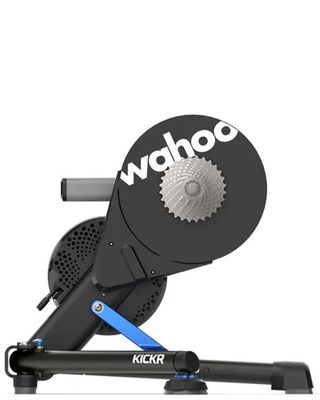
Bluetooth, ANT+, DirectConnect and WiFi connection. Side-to-side rocking motion for comfort. 2200-watt resistance and 1% accuracy with realistic pedalling feel, a stable platform and easy to carry handle. Weighs 22kg. Cassette included.
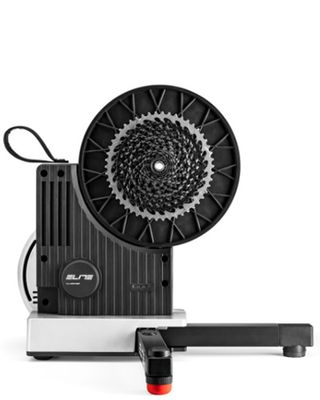
2300-watt resistance, 24% gradient simulation, 1% accurate and side-to-side motion for comfort. Cheaper than the Kickr, but no WiFi. Can be used without mains power. Carry handle. Weighs 17kg. Cassette not included.
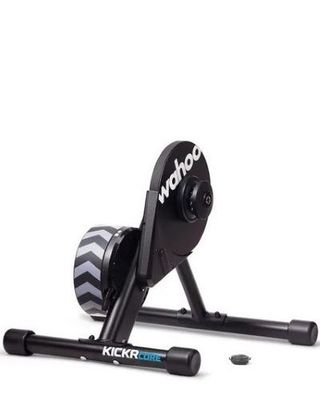
The Wahoo Kickr Core Zwift One merges Wahoo's smart trainer with the single sprocket Zwift Cog, with a virtual 12 speed shifter on your bars. It's the same price as the Kickr Core with a cassette between 8 and 12 speeds, giving you the option of real shifting.
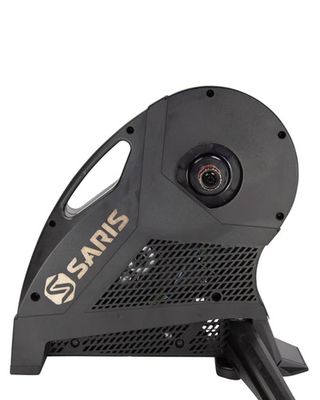
High specs at vastly reduced RRP. Old model but still available worldwide. 2000w resistance, 20% gradient simulation, 2% accuracy. 9kg flywheel for realistic pedalling feel. No rocking motion for comfort. No WiFi. Cassette not included. Good carry handle. Weighs 21kg.
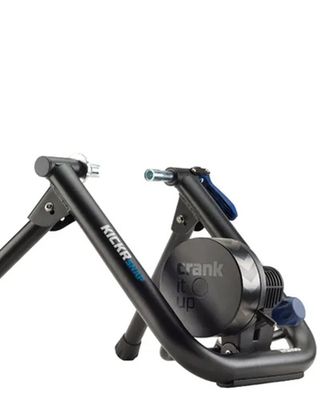
Great wheel-on trainer with good app compatibility. 1500-watt resistance, 12% gradient simulation, 3% accuracy. Weighs 17kg. Folding legs. No carry handle. Easy to set up and highly durable.
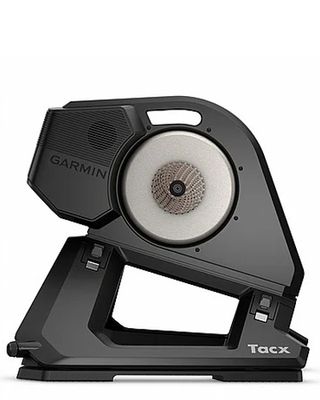
With 1% accuracy, 2200 watts of resistance, 25% gradients and electronic virtual 125kg flywheel, motion plates and Bluetooth/ANT+/WiFi connectivity, it's one of the most premium on the market. Sadly, that's reflected in the price.

I've been using a smart trainer to ride and race on Zwift, TrainerRoad and others since 2018. In my time at Cyclingnews, I've used more indoor trainers than I can recall, putting them all through a series of test rides to work out their accuracy, responsiveness and how easy they are to live with.

Josh has ably assisted our indoor trainer testing for the past four years, and is regularly found riding and racing on Zwift. He's covered well in excess of 1000 hours on the platform alone, using trainers from the budget-friendly Kickr Core, through to the premium Tacx Neo 3M and plenty of smart bikes too.
Best direct drive turbo trainers
For direct drive trainers to function, you'll need to remove your rear wheel. The trainer itself will have a cassette fitted (although it's not always included), and you'll connect your bike to it in a similar way you'd fit a rear wheel. This means your pedalling turns the flywheel directly, rather than turning a wheel and then relying on friction between your tyre and a roller.
It's important to get a smart trainer that is compatible with the axle on your bike and ensure that the freehub body - the part that the cassette fits onto - is compatible with your groupset. You can't fit a 12-speed SRAM cassette onto an 11-speed Shimano freehub, for example.
Almost all trainers come with an 11-speed-compatible Shimano freehub, so if you are using SRAM or Campagnolo, expect to have to spend a little more to make it fit.
Best smart trainer overall
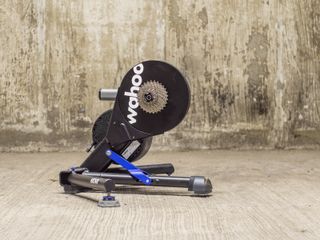
Specifications
Reasons to buy
Reasons to avoid
The Kickr V6 is my pick of the best overall because it offers the most rounded balance of high-spec performance, excellent ride feel, comprehensive connectivity and price.
I'll tackle that last point first: the Kickr is among the more expensive smart trainers around, and if you're looking for a budget offering to get rolling indoors, then the Wahoo Kickr Core Zwift One below will do that at a much lower price. But when it comes to the best smart trainers, things like pedalling inertia (from the heavier flywheel) and the amount of available resistance will improve the quality of the ride. There's also an improvement in the accuracy to which your power output is transmitted to your chosen indoor cycling app.
The Kickr's top level specs are 2200-watt resistance, 20% gradient, 1% accuracy and five-degree left-right movement courtesy of the Axis feet, in a package that comes with a cassette included, folds down for storage and will automatically calibrate itself each time you ride.
The Elite Justo (below) actually offers a slightly better package if we're just looking at those features, but where the Kickr stands out against that and other similarly-priced trainers is connectivity. All smart trainers will offer Bluetooth and ANT+ connections, but the Kickr offers three simultaneous Bluetooth connections (which is great for avoiding dropouts), as well as WiFi (which allows your Kickr to talk to your computer via your home WiFi network) and Direct Connect via an adaptor and an ethernet cable for a totally wired connection.
It also offers a feature called ERG EasyRamp, which allows you to restart hard intervals without the leg-sapping standing start, if ever you stop mid-effort.
It's worth noting that the Kickr Move (below) also offers all of these features alongside even more movement. If you really want to push the boat out, that is an excellent trainer that you'll be very happy with, but the price is even higher.
You can read more in our Wahoo Kickr 2022 review.
Runner up
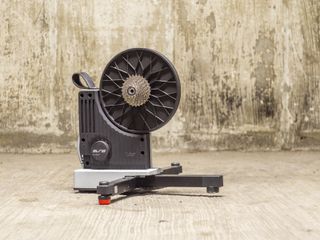
Elite Justo
Specifications
Reasons to buy
Reasons to avoid
The Elite Justo is a high quality smart trainer that looks great, offers excellent specs, has performed brilliantly in around a year's worth of my testing, and does the basics well. It narrowly misses out on the top spot in this guide due to the value I place on the WiFi connectivity, but if you don't think that's necessary for you, then you should save yourself some cash and buy this instead.
The top line specs include 2,300 watts of resistance, gradients of up to 24% and power accuracy within 1%. It will also self-calibrate, fold away neatly for storage, and comes with similar Flex feet that offer side to side motion for comfort.
Its flywheel is lighter than the Kickr at 6.2kg, meaning the total unit weight is also lighter at 17kg, but it's actually slightly harder to carry around because instead of a solid handle, it uses a leather loop. The one other downside is that it doesn't come with a cassette, so you'll have to factor in the cost of that if you don't have a spare at home.
Those aside, I particularly like that it can be used without mains power, which makes it a viable option for raceday warmups.
Best budget direct-drive
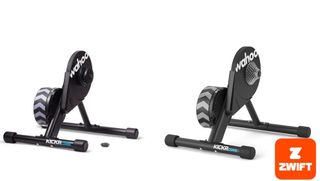
Wahoo Kickr Core
Specifications
Reasons to buy
Reasons to avoid
Wahoo and Zwift have settled their spat over patent infringement amicably, as we explain in detail in our interview with the two brands. This has resulted in Zwift discontinuing its Hub One trainer, while Wahoo now offers the Kickr Core Zwift One, which adds Zwift's single sprocket Zwift Cog and virtual 12-speed shifting to the Kickr Core.
It sits alongside the 'classic' Wahoo Kickr Core, which comes with a standard cassette with between 8 and 12 speeds, so you've got the best of both worlds, depending on your shifting preference. Both include a year's Zwift subscription.
The Kickr Core Zwift One is recommended if you want virtual shifting (this will only work in Zwift itself, not Rouvy, MyWhoosh, etc) and the Kickr Core is the one for mechanical shifting and if you want a wider choice of indoor cycling apps.
The Kickr Core features a 1,800-watt maximum resistance, 16% gradient simulation and a power accuracy of 2%. It doesn't fold away, nor does it come with a carry handle (although at ~15kg, I never had much issue moving it as the fixed feet are quite easy to grab).
The Kickr Core is not going to trouble the likes of the Kickr or the Neo 3M on specs, but at half the price of the Kickr V6, with a year's subscription to Zwift included, its value is unmatched and the Zwift Cog virtual shifting removes one complication from your indoor training.
Read our Wahoo Kickr Core Zwift One trainer review for more details.
An added benefit of the single speed 'cog' and 'click' virtual shifting is that the broad compatibility means it's compatible with all 8-12-speed groupsets so you can easily swap between bikes, making it useful for multi-rider households.
Of the two, it's the one to buy if you only ever ride on Zwift when indoors, have a multi-rider household (or multiple Zwift bikes) and/or have nearby neighbours/flatmates who could get tired of the noisy clunking of gear changes.
Want to know more? Read our Wahoo Kickr Core Zwift One review
The Wahoo Kickr Core with a traditional cassette allows you a choice of drivetrain speeds when buying, meaning your shifting is done by your own bike's groupset and using your shift levers. This does mean that you'll have to swap the cassette if ever you swap bikes indoors to one with a different groupset.
This is the one to buy if you plan on using apps other than Zwift, or if you prefer the realism and feel of traditional shifting.
Want to know more? Check out our Wahoo Kickr Core review.
Best smart trainer for high specs at a lower price
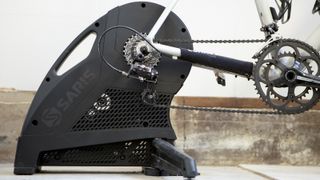
Specifications
Reasons to buy
Reasons to avoid
In terms of specs, the Saris H3 sits roughly between the more expensive Wahoo Kickr and the more affordable Kickr Core, and it does so at a price that is competitive, especially when it's on offer (which is common).
It offers 2% accuracy, with up to 2,000 watts of interactive resistance from any of the popular apps and can simulate gradients of up to 20%. With a substantial 9kg/20lb flywheel to drive, the Saris H3 also offers excellent inertia with electromagnetic resistance, alongside quiet operation.
The legs fold away, and there’s and carry handle so you don’t throw out your back trying to move the 21.3kg unit. It also comes with adaptors to suit most modern bike axles (except mountain bike Super Boost). It doesn't come with a cassette, though, so bear that in mind when buying.
It doesn't offer the flexy feet of the Kickr or the Justo though, nor does it offer multiple simulatneous Bluetooth connections or WiFi, which may sway you in favour of the more expensive options. It's still a great option if you want the higher resistance without the added features though.
Most realistic ride
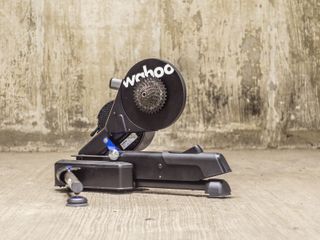
Wahoo Kickr Move
Specifications
Reasons to buy
Reasons to avoid
The Wahoo Kickr Move takes the Kickr V6 from above and essentially mounts it onto an eight inch rolling track that lets your bike slide forward and backwards, as well as rock side to side slightly. This means it has all the great specs and connectivity of our 'best overall' smart trainer, but with additional comfort and ride realism.
That extra functionality does come at a cost, though, so you'll have to decide whether that's something you want from your indoor setup. Bear in mind too that for less money you could pair a Kickr V6 with a budget rocker plate.
In my experience testing the Kickr Move, the extra movement meant I was engaging my core more when riding. That was slightly more tiring to begin with, but after a few rides it felt great and led to more comfort towards the end of long rides. This is more reflective of real world riding, and offers a more rounded workout, hence I've awarded it the best smart trainer for a realistic ride feel.
Just be careful when setting up that your Kickr is perfectly level though. I found myself settling into a not-quite-upright position on the first few rides because the feet weren't level and the lateral movement, albeit minimal, is quite 'free'.
Money no object
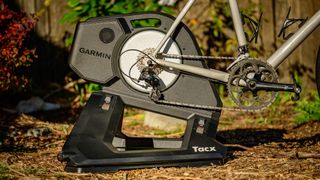
Specifications
Reasons to buy
Reasons to avoid
The Neo 3M from Tacx (a subsidiary of Garmin) is the most expensive option on this list, and the most expensive direct drive trainer on the market (excluding smart exercise bikes, of course).
On paper, its specs are similar to the not-quite-as-expensive Wahoo Kickr Move: 2,200 watts of resistance, 1% accuracy, 25% gradient simulation, feet that let it move back and forth as well as rock left and right, and Bluetooth/ANT+/WiFi connectivity.
However where it edges ahead is in the virtual flywheel, a feature originally seen on the Neo 2T (below). This adjusts the inertia based on your weight and better simulates that real-ride feel, speeding up when descending just like you would in the real world. It also means the responsiveness of ERG Mode is incredibly accurate. It even means the Neo 3M can work without mains power, so it can be taken to the car park for your next race warmup.
Like the Neo 2T, it offers individual pedal stroke analysis, the added rumbling feature that literally shakes the trainer when you go over rough ground in Zwift, and Garmin listened to our complaints (maybe) by adding a carry handle to make it easier to move around. It does still weigh 52lbs (23.5kg) though, so try not to make it a habit.
To summarise, the Tacx Neo 3M is definitely a 'bells-and-whistles' trainer for those who want the very best ride feel, all the added features and the most amount of 'future proofing' available, but I find it hard to justify the cost over the Neo 2T, the Kickr V6, or the largely similar Kickr Move.
Great flywheel feel at a lower price
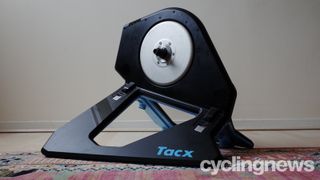
Specifications
Reasons to buy
Reasons to avoid
The Neo 2T offers a clever motorised flywheel that not only replicates a flywheel much heavier than it actually is, but also provides added features such as replicating rough roads. So if you are riding in Zwift and you cross gravel, cobbles or wooden bridges the trainer will shake in different ways to mimic the road feel. The Neo 2T and 3M are also the only trainers here that use a motor to accelerate the flywheel during descending, replicating your rear wheel in real life.
Using electromagnetic resistance, Tacx says it can simulate up to a 125kg flywheel and offers 2,200 watts to fight against and a max incline of 25% with 1% accurate power readings. It's also compatible with 135x10, 142x12 and 148x12mm axles without the need for extra adaptors. Like the Justo, it can even be unplugged and still function meaning it's workable for your pre-race car park warm-up.
On top of those features, there's a bit of side-to-side movement built into the design and if that's not enough you can add the aftermarket Garmin Tacx NEO Motion Plates for around 5cm of fore/aft movement as well.
The Neo 2T also offers advanced power metrics like left/right balance and pedal stroke analysis.
The legs do fold, but it doesn't have a carry handle, so at 21.5kg, it's quite a difficult one to move around. I found myself giving it a bear hug when trying to transport it from place to place.
Read more in our Tacx Neo 2T review.
Best smart trainer for portability
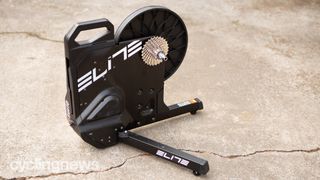
Specifications
Reasons to buy
Reasons to avoid
The Elite Suito is the Italian brand's third-tier turbo trainer, sitting beneath the Direto XR and the Justo (above) in the range. The Suito comes completely assembled, with the 11-speed Shimano cassette fitted, so setup is simple for anyone using an 11-speed groupset. It's also available without a cassette, marketed as the Suito-T, which will be of use to anyone running 12-speed.
Once ready, the Suito is adequately quiet in operation. It provides resistance up to 1,900 watts, power readings accurate to within +/-2.5%, and with simulated gradients up to 15%.
It has foldable legs, with adjustable feet to stabilise on uneven ground, plus a carry handle. While its 3.5kg flywheel results in less inertia and a less realistic ride feel, it's still a world apart from that 'pedalling through mud' feeling from years gone by.
It also means it's lighter, which when combined with the folding legs and carry handle, mean you're getting an excellent trainer for packing away at the end of the ride. There are many who choose to leave their smart trainer ready to go all the time but if you have to tidy up after yourself, then the Suito might make life that little bit easier.
Want to know more? Have a look at our Elite Suito review.
| Header Cell - Column 0 | Wahoo Kickr V6 | Elite Justo | Wahoo Kickr Core | Saris H3 | Kickr MOVE | Tacx Neo 3M | Tacx Neo 2T | Elite Suito |
|---|---|---|---|---|---|---|---|---|
| Best for | Best overall | Runner up | Best budget direct drive | Cheapest high-spec | Best for realistic ride feel | Money-no-object choice | Great flywheel feel at lower price | Most portable |
| Retail price | £1,099.99 / $1,299.99 / €1,299.99 / AU$1,799.95 | £999.99 / $1,199.99 / €949.99/ AU$tbc | £549.99 / $599.99 / €599,00 / AU$tbc | £749.99 / $799.00 / €tbc / AU$tbc | £1,399.99 / $1,599.99 / €1,599.99 | £1,749.99 / $1,999.99 / €1,999.99 | £1,049.99 / $1,399.99 / €1.299,00 / AU$2,399.00 | £639.99 / $799.00 / €569.00 / AU$1,189.95 |
| Type | Direct drive | Direct drive | Direct Drive | Direct drive | Direct drive | Direct drive | Direct drive | Direct drive |
| Can transmit power to apps | Yes | Yes | Yes | Yes | Yes | Yes | Yes | Yes |
| Can be controlled by apps? (ie ERG Mode) | Yes | Yes | Yes | Yes | Yes | Yes | Yes | Yes |
| Mains power required? | Yes | No | Yes | Yes | Yes | No | No | Yes |
| ANT+ FE-C | Yes | Yes | Yes | Yes | Yes | Yes | Yes | Yes |
| Bluetooth Smart | Yes | Yes | Yes | Yes | Yes | Yes | Yes | Yes |
| WiFi | Yes | No | No | No | Yes | Yes | No | No |
| Multiple simultaneous Bluetooth connections | 3 | 2 | 1 | 1 | 3 | 2 | 1 | 1 |
| Power calibration | Automatic | Automatic | Manual | Manual | Automatic | Automatic | Automatic | Manual |
| Power accuracy | 1% | 1% | 2% | 2% | 1% | 1% | 1% | 2.50% |
| Max resistance | 2,200w | 2,300w | 1,800w | 2,000w | 2,200w | 2,200w | 2,200w | 1,900w |
| Max simulated gradient | 20% | 24% | 16% | 20% | 20% | 25% | 25% | 15% |
| Added reality features | Axis feet | Elite Flex Feet | N/A | N/A | Fore/aft movement | Fore/aft movement, Rumbling over rough ground, virtual flywheel | Rumbling over rough ground, virtual flywheel | N/A |
| Unit weight | 22kg / 47lb | 17kg / 38lbs | 18kg / 40lb | 21.3kg / 47lb | 29kg / 64lbs | 23.5kg / 52lbs | 21.5kg / 47.4lb | 14.5kg / 32lb |
| Flywheel weight | 7.25kg / 16lb | 6.2kg | 5.4kg / 11.9lb | 9kg / 20lb | 7.25kg / 16lb | Virtual 125kg / 275.5lb | Virtual 125kg / 275.5lb | 3.5kg / 7.7lb |
| Carry handle? | Yes | Yes | No | Yes | Yes | Yes | No | Yes |
| Cassette included | Shimano 11sp - 11-28t | No | Yes, 8 - 12sp or Zwift Cog | No | Shimano 11sp - 11-28t | Shimano 11sp - 11-28t | No | Shimano 11sp |
| Axle compatibility | QR, 12x142, 12x148 | QR, 12x142, 12x148 | QR, 12x142, 12x148 | QR, 12x142, 12x148 | QR, 12x142, 12x148 | QR, 12x142, 12x148 | QR, 12x142, 12x148 | QR, 12x142 |
Best wheel-on turbo trainers
Like direct drive trainers, wheel-on turbo trainers hold your bike aloft via the rear axle, but they differ in that you don't remove the wheel. Instead, your rear tyre is placed against a roller so that when your pedalling input spins your rear wheel, it in-turn spins the roller. The resistance is then applied to that roller, which in turn makes it harder to pedal.
Best wheel-on trainer overall
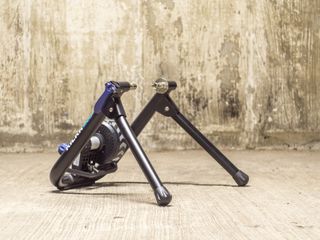
Wahoo Kickr Snap
Specifications
Reasons to buy
Reasons to avoid
If you're looking for a smart trainer, direct drive is the type we'd recommend you go for, but if for some reason you need to stick with a traditional wheel-on trainer option then you needn't look beyond the Wahoo Kickr Snap.
With both ANT+ and Bluetooth connectivity, Wahoo makes the unit compatible with basically every training app under the sun and the Kickr Snap plays nicely with iOS, Android, Windows and Mac.
At +/-3% accuracy, the power measurement of the V2 edges in just above much of the wheel-on competition and in the ERG mode, the Kickr Snap adjusts the resistance at the rear wheel to match what your app of choice dictates.
The frame is sturdy and doesn't feel as though you're going to tip over when the intervals get tough, but the legs are foldable for easy storage. It's pretty easy to buy no matter where in the world you live, and it's easy to find spares should you have any issues.
Best wheel-on trainer for easy setup
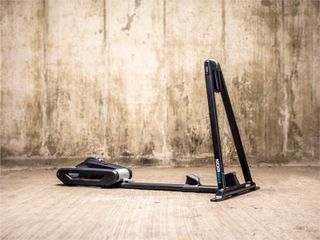
Specifications
Reasons to buy
Reasons to avoid
The Wahoo Kickr Rollr is technically a wheel-on smart trainer but it's unlike anything else on this list. For many years a roller system was the most natural ride quality available when riding inside. The downside though was the ability to fall off. If you weren't careful, you'd find yourself on the ground. As smart trainers rose in popularity the fact that rollers lacked a hard connection to the bike meant that it was difficult to integrate resistance and power measurement. With the Wahoo Kickr Rollr, the brand thinks it's overcome these challenges.
There's no system for bolting your bike to the trainer because all you do is set the bike onto the trainer and secure the front wheel with a hoop. The rear wheel moves just like it would on traditional rollers but there's no risk of falling so it's possible to integrate resistance. Then, sidestepping power measurement issues, you'd want to bring your own option from our list of the best power meters.
The ease of use of the system makes it ideal for those who want a natural feel and fast bike connection. If you've got multiple bikes in the household and everyone has different groupsets and tyres it's still just as easy to put the bike on and get started riding. It's also a good choice if you prefer riding outside, already have a power meter, but sometimes need another option.
One thing to consider though is that Zipp has specifically warned against using its wheels with the Wahoo Kickr Rollr. We will keep an eye on the news as it develops but for now at least, you'll want to swap wheels if you've got something from Zipp.
Want to know more? Have a look at our Wahoo Kickr Rollr review.
| Header Cell - Column 0 | Wahoo Kickr Snap | Wahoo Kickr Rollr |
|---|---|---|
| Best wheel-on | Easiest setup | |
| Retail price | £299.99 / $349.99 / €399.99 / AU$699.95 | £699.99 / $799.99 |
| Type | Wheel on | Wheel on |
| Can transmit power to apps | Yes | Yes |
| Can be controlled by apps? (ie ERG Mode) | Yes | Yes |
| Mains power required? | Yes | Yes |
| ANT+ FE-C | Yes | Yes |
| Bluetooth Smart | Yes | Yes |
| WiFi | No | No |
| Multiple simultaneous Bluetooth connections | 3 | 3 |
| Power calibration | Manual | Manual |
| Power accuracy | 3% | N/A |
| Max resistance | 1,500w | 1,500w |
| Max simulated gradient | 12% | 10% |
| Added reality features | N/A | N/A |
| Unit weight | 17.2kg / 38lb | 22.7kg / 50lb |
| Flywheel weight | 4.8kg / 10.5lb | 4.8kg / 10.5lb |
| Carry handle? | No | No |
| Axle compatibility | QR (Thru axle sold separately) | N/A |
Also consider
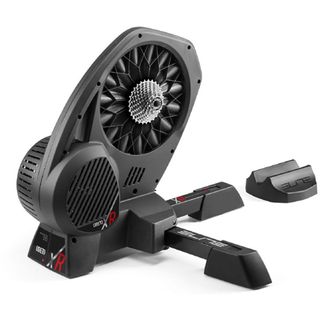
This high-spec trainer comes at a decent price and has a good reputation for durability. It has 2300 watts of resistance, 24% gradients and 1.5% accuracy. It's not as cheap as the similarly-specced Saris H3, and the flywheel could be heavier, but it comes with a cassette and is fairly portable at 15.8kg.
Read our Elite Direto XR review
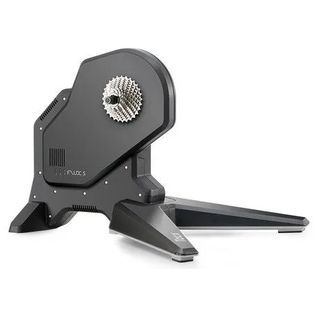
With 1500 watts of resistance, 10% gradients and accuracy of +/-3%, the Tacx Flux S offers specs that don't quite match up to the other smart trainers on this list, but the retail price is pretty competitive and it's regularly on offer. It's not for people who need portability though, as it doesn't fold, doesn't have a carry handle and weighs 50lbs/23kg.
Read our Tacx Flux S review
How to choose the best turbo trainer
To the uninitiated, bike trainers (commonly known as turbo trainers, indoor trainers, or when applicable, smart trainers) can present a confusing minefield of options, but that's where we can help.
Firstly, you'll need to decide between smart and standard. While the trend of the best bike trainers of today definitely favours smart trainers, standard options are still produced and widely popular due to their budget-friendly price.
Smart means they can connect (usually via Bluetooth or ANT+) to your electronic device (phone, laptop, tablet and most of the best cycling computers) to offer variable resistance which is controlled by indoor cycling apps such as Zwift or workout sessions downloaded to your cycling computer from coaching software such as TrainingPeaks.
When buying, look for connectivity specs and compatibility claims. If it has Bluetooth or ANT+ mentioned, or it claims to be compatible with Zwift, then you're looking at a smart turbo trainer.
Standard bike trainers forego this connectivity and are much cheaper. They either offer a progressive resistance curve (the harder you pedal, the more it resists), or a manual controller, which works in a similar way to dragging the brakes. Of course, if you have a power meter or speed sensor, you can pair those with your Zwift-running device, but the interactivity is lost (Zwift can't control the resistance automatically).

Within smart trainers, there are two options: wheel-on and direct drive. Just as the names suggest, wheel-on lets you keep your rear wheel on your bike, and places a roller against your tyre to provide resistance. Direct-drive trainers connect a cassette to the trainer itself, and remove the rear wheel altogether.
The most significant factor in determining which turbo trainer is best for you will be how much you're willing to spend. Direct drive turbo trainers are definitely better, but also more expensive, the wheel-on smart variety is more budget-friendly, and standard (non-smart) turbo trainers are regularly the cheapest.
Of course, there is a trade-off. The wheel-on trainers are usually louder and don’t offer the same power-measuring accuracy as their direct drive counterparts. Tyre wear can be an issue, so you can buy a trainer-specific tyre with harder rubber.
If you are starting from scratch and are a little unsure about what other equipment you need to start riding indoors, have a look at our comprehensive guide to indoor cycling.
How do I find a trainer that's compatible with my axle and freehub?
Bikes use a variety of axle and freehub standards these days, so it's essential to check which your bike uses and make sure the turbo trainer you buy comes with the correct adaptors.
Axles
Most modern bikes use either a 135mm quick-release (QR) skewer or a 142x12mm thru-axle. All of the trainers above are compatible with both, but some will require an extra purchase to make it work. We've outlined the compatibility of each trainer to help you decide which is the best turbo trainer for you.
Many mountain bikes these days use a slightly wider 148x12mm Boost thru-axle, so if you're a mountain biker and wish to use it on the trainer, then you'll need to consider this when buying.
If your turbo trainer of choice doesn't come with the correct adaptor to suit your bike, then it will most likely be available as an aftermarket extra purchase, but of course, this is an extra cost you may be able to do without.
Freehubs
When it comes to direct drive trainers, you'll need to consider whether the freehub is compatible with a cassette that is compatible with the groupset on your bike.
The agreed-upon standard is for a turbo trainer to come with a freehub that's compatible with 9, 10 and 11-speed Shimano/SRAM cassettes. So if you're using a groupset of that spec, you'll probably find you have no issues with freehub compatibility. However, if you're using Campagnolo, Shimano Micro Spline 12-speed (but not road-going 12-speed), or SRAM 12-speed groupsets, you'll need a different freehub, which will be an additional extra purchase to consider.
Cassettes
If buying a direct drive turbo trainer, it's also worth considering whether or not your prospective new turbo trainer comes with a cassette or not. Some turbo trainers come with an 11-speed cassette included, which can help save money (assuming it's compatible with your bike, of course).
You can spec an 8, 9, 10, 11 or 12 speed cassette with the Wahoo Kickr Core.
We've made it clear for each of the turbo trainers above which, if any, cassette is included.
Can a cycling trainer ever damage my bike?
Riding a bike on an indoor trainer can place a unique set of forces through certain parts of your frame and in particular the rear dropouts. It's first important to check that your bike is actually compatible with use on a turbo trainer. Most new bikes are, but your bike's manual should offer details, and Wahoo has its own bike compatibility chart for extra help.
Correct installation of your frame and regular checks are important to ensure nothing is ever damaged. Don't just clamp your bike onto a trainer and ride it all winter without checking things over, especially after a few hard sessions.
It's also really important to protect your bike and components from corrosive sweat if you're doing a lot of riding on your indoor trainer. We like to drape a towel over the handlebars to catch the majority of the sweat, and a wipe down after each use and regular bike wash will keep everything working as it should.
For a more detailed answer, check out our in-depth article covering whether a trainer can damage your frame.
What is ERG mode?
ERG mode is where the trainer will tailor the resistance to help you hit your target power, and is a feature of all smart turbo trainers. For example, let's say you're riding a preset workout and your target power is 200 watts. ERG mode will provide the right resistance for 200 watts regardless of whether you're pedalling at 60RPM or 150RPM.
This means you can focus more on the pedalling and less on shifting gears or ensuring you remain on target. It's also a big point of differentiation for every smart trainer.
The hardware has the ability to almost instantly lock you to a specific power level but our bodies don't respond like that. Our pedalling isn't perfect and our power output vs cadence varies. The way that different manufacturers tune the software to respond to those realities changes the feeling of the ride.
Some companies are faster for tighter adherence to specific power outputs. Wahoo follows this strategy. Other companies, like Elite, intentionally respond a little slower to provide a more natural feeling ride even if your intervals aren't as tight. You'll want to think about how you ride when you consider which brand of trainer is right for you.
Which apps are compatible with my smart trainer?
When it comes to communication with your device, almost every smart trainer can connect via Bluetooth Smart FTMS (the FiTness Machine Service designed specifically for Bluetooth fitness equipment) or ANT+ FE-C. Both allow your trainer to speak to and receive commands from your computer, meaning you can ride in ERG mode or have the resistance affected by the terrain in Zwift.
ANT+ FE-C can generally accept multiple connections at once, so you can record data on multiple devices or have your trainer controlled by TrainerRoad whilst following roads in Zwift for entertainment. Bluetooth is usually limited to one concurrent connection, although Wahoo devices support up to three.
As of around 2016, virtually every smart trainer on the market is dual-band, meaning they work on both protocols, so no matter if you're using a Garmin cycling computer or your Bluetooth smartphone, your smart turbo trainer should be able to speak the right language.
Remember, a standard trainer forgoes this technology, so cannot communicate with your device at all.
How do we test the best smart trainers?
When it comes to indoor cycling we are a passionate group at Cyclingnews.
The first step is pulling it out of the box, noting which adaptors come included, and how easy it is to fit our bike to the trainer. Next up comes the software check, where we see how easy any accompanying app is to navigate and how stable the Bluetooth and ANT+ connections are to our various devices.
When we test indoor cycling gear we take it through a range of different use cases. TrainerRoad is an excellent way to check the response of a trainer in ERG mode and we check that using short intervals as well as long ones. We also make sure we race in Zwift to see how the hardware handles race situations and we do some free riding in Zwift or Rouvy to compare ride feel in a more relaxed situation.
We'll also use the trainer alongside a couple of on-bike power meters to make sure the readings from the trainer are correct across various power durations, from short sprints to long steady efforts.
Get The Leadout Newsletter
The latest race content, interviews, features, reviews and expert buying guides, direct to your inbox!

As the Tech Editor here at Cyclingnews, Josh leads on content relating to all-things tech, including bikes, kit and components in order to cover product launches and curate our world-class buying guides, reviews and deals. Alongside this, his love for WorldTour racing and eagle eyes mean he's often breaking tech stories from the pro peloton too.
On the bike, 32-year-old Josh has been riding and racing since his early teens. He started out racing cross country when 26-inch wheels and triple chainsets were still mainstream, but he found favour in road racing in his early 20s and has never looked back. He's always training for the next big event and is keen to get his hands on the newest tech to help. He enjoys a good long ride on road or gravel, but he's most alive when he's elbow-to-elbow in a local criterium.
